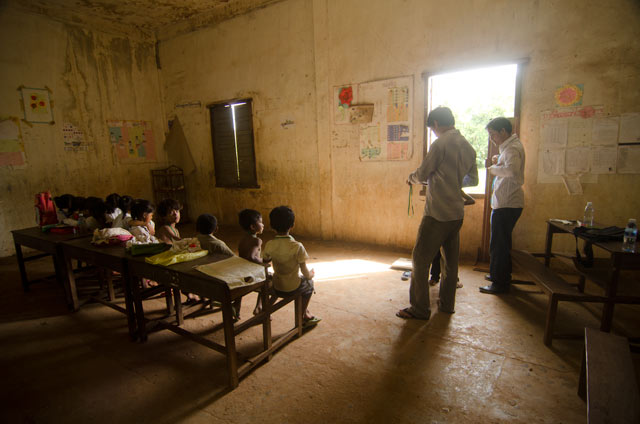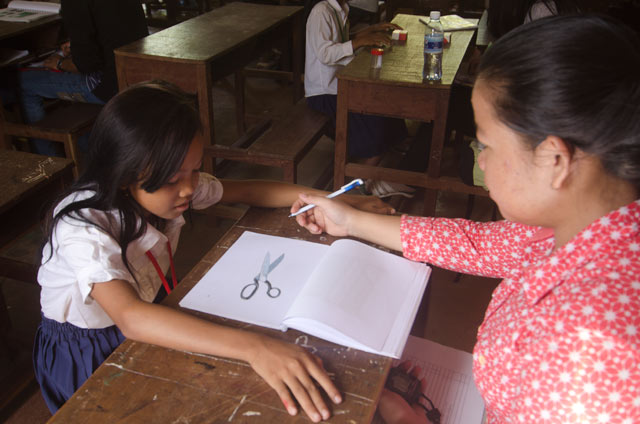The scourge of childhood across the country, malnutrition could be beaten in one simple and inexpensive measure
Text and photos by Denise Hruby
The triangles won’t fit. For several minutes, Un Koy has been trying to assemble the red and white figures as shown in an example. The stopwatch rings, signalling that the eight-year-old girl from Kompong Speu province has failed the cognitive test.

At first glance, Koy looks like most children in her crowded elementary school. Her straight, black hair is tied in a ponytail, her school uniform is slightly dirty, and, as she runs across the schoolyard, she keeps slipping out of her shoes.
But standing at a little over a metre, Koy is much smaller than her peers. Malnourished, her simple rice diet is believed to be the chief reason for this stunted growth. Rice is the main, and on some days the only, staple for most rural Cambodians. Lacking in minerals and vitamins, this largely single-source diet causes the brain and other organs to underdevelop. According to the United Nations, more than 40% of children are malnourished in Cambodia, where about 40% of the population is aged 18 and under.
For generations, the physical development of children in developing countries has been hampered by a low intake of nutrients. However, the solution for rice-based societies could lie in rice fortified with essential nutrients.
A pilot project by the Institute de Recherche pour le Développement (IRD) and the World Food Programme (WFP) in Cambodia’s Kampong Speu province is testing whether simply adding fortified rice to schoolchildren’s diets has a dramatic effect on their learning capabilities and long-term development.
“Stunting is just a sign that the body is not developing the way it should, and that affects all organs, including the brain,” said senior IRD researcher Frank Wieringa, who leads the project in Kampong Speu. This directly affects children’s performance in school.
Globally, malnourished children score 7% worse in math tests and are 19% less likely to read at the age of eight, according to a recent report by Save the Children. Additionally, there are devastating long-term disadvantages for children who are left behind.
“Children who are malnourished go on to earn 20% less as adults than the children who are well nourished, with some experts putting that figure as high as 66%,” states the Save the Children report.
Malnourished children, who are likely to drop out of school earlier than healthy students, could cost a country’s GDP between 2% and 11%. Adults who were malnourished as children are also more likely to suffer from non-communicable diseases, such as hypertension and obesity.
“We have all these non-communicable diseases in adults that are all linked to malnutrition in childhood,” Wieringa said. “If you are stunted as a child or malnourished in the womb, your body thinks the outside world is not good, so it better put on weight when it gets nutrients. Obesity is not just what people are eating at the moment, but also how they are programmed to process food as infants,” Wieringa said, citing as examples Vietnam and Indonesia, where obesity rates in adults are skyrocketing.

As the IRD project hopes to show, simply adding minerals and vitamins to rice could help prevent a health crisis in the next generation of adults. The inexpensive process involves pressing rice flour that has been fortified with nutrients into rice-sized grains and added to conventional rice.
In cooperation with the WFP – which has served nutritious meals in Cambodian schools since 1999 through a project that currently benefits some 400,000 children – IRD has provided fortified rice to about 2,000 children in 16 elementary schools in Kampong Speu province since November last year. This should be enough time to record a large impact on the health of the children, Wieringa said.
In different surveys, his team tests the children’s health by taking blood, urine and stool samples, and by measuring weight and height. A team of psychology students also conducts simple cognitive tests to determine whether learning capabilities improved as a result of the new diet.
The final results of the surveys won’t be known until November, but Wieringa remains hopeful.
“We will find an impact on the nutritional state of the children. But I hope that we are able to show more; to show that we improved the functional outcomes as well, such as the ability to learn, to impact their growth… and I hope to show an effect on their general health, such as that they don’t get diarrhoea anymore and therefore can go to school more frequently,” Wieringa said.
Currently, the WFP spends about $23 annually to feed one child one meal per day in a Cambodian school. For an extra $0.50 per year, the rice that is already a part of these meals could be fortified with those crucial vitamins. “WFP plans to scale up the use of fortified rice in the school meals programme and other food-based social safety net programmes in Cambodia,” said Somealea Ngay, WFP Cambodia’s senior public information assistant.
This will directly benefit about 400,000 children in more than 1,300 schools across the country, helping a generation of Cambodians to live up to their potential.
Also view:
“Battling the bulge” – Children in Malaysia have been labelled the fattest in the region, but their weight carries a greater burden than just their size
“Mother’s milk” – Big business is threatening the Philippines’ progressive breastfeeding culture
“In numbers: infant mortality improves” – The welfare of children has dramatically improved in the past ten years. It is an encouraging trend – but massive disparities remain between nations
